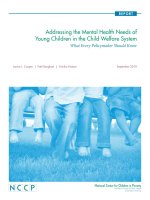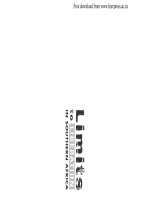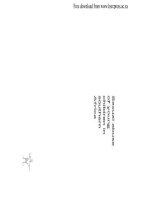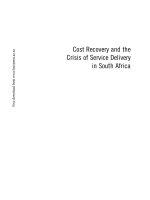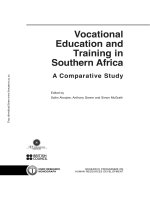Sexual Abuse of Young Children in Southern Africa ppt
Bạn đang xem bản rút gọn của tài liệu. Xem và tải ngay bản đầy đủ của tài liệu tại đây (1.48 MB, 496 trang )
Free download from www.hsrc
p
ress.ac.za
Free download from www.hsrc
p
ress.ac.za
Edited by Linda Richter,
Andrew Dawes and
Craig Higson-Smith
Free download from www.hsrc
p
ress.ac.za
Compiled by the Child, Youth and Family Development Research Programme,
Human Sciences Research Council
Published by HSRC Press
Private Bag X9182, Cape Town, 8000, South Africa
www.hsrcpublishers.ac.za
© 2004 Human Sciences Research Council
Funded by the Ford Foundation
First published 2004
Second impression 2005
All rights reserved. No part of this book may be reprinted or reproduced or
utilised in any form or by any electronic, mechanical, or other means, including
photocopying and recording, or in any information storage or retrieval system,
without permission in writing from the publishers.
ISBN 0 7969 2053 2
Cover by Amaal Bruwer
Production by comPress
Distributed in Africa by Blue Weaver Marketing and Distribution,
PO Box 30370, Tokai, Cape Town, 1966, South Africa.
Tel: +27 +21-701-4477
Fax: +27 +21-701-7302
email:
Distributed worldwide, except Africa, by Independent Publishers Group,
814 North Franklin Street, Chicago, IL 60610, USA.
www.ipgbook.com
To order, call toll-free: 1-800-888-4741
All other enquiries, Tel: +1 +312-337-0747
Fax: +1 +312-337-5985
email:
Free download from www.hsrc
p
ress.ac.za
Contents
Foreword ix
Graça Machel
Note from the Ford Foundation xi
Dr Gerry Salole
Acknowledgements xiii
Abbreviations xiv
1. Confronting the problem 1
Andrew Dawes, Linda Richter and Craig Higson-Smith
Section I: Talking about child sexual abuse 19
2. The many kinds of sexual abuse of young children 21
Linda Richter and Craig Higson-Smith
3. Media representations of baby rape: the case of ‘Baby Tshepang’ 36
William Bird and Nicola Spurr
Section II: Understanding child sexual abuse 53
4. Individual and contextual factors associated with the sexual abuse
of children under 12: a review of recent literature 55
Loraine Townsend and Andrew Dawes
5. The socio-cultural context of child abuse: a betrayal of trust 95
Mthobeli Guma and Nomvo Henda
6. Responses to gender-based violence in schools 110
Heather Brookes and Craig Higson-Smith
Free download from www.hsrc
p
ress.ac.za
7. Child sexual abuse and HIV infection 130
Rachel Jewkes
8. Commercial sexual exploitation and trafficking of children 143
Craig Higson-Smith and Linda Richter
9. Measurement and monitoring 176
Andrew Dawes, Jacqueline Borel-Saladin and Zareena Parker
Section III: Legal and policy responses 207
10. Legal definitions and practices in child sexual abuse 209
Jacqui Gallinetti
11. Challenges of service evaluation in the Wynberg and Cape Town
Sexual Offences Courts and their related services 227
Mastoera Sadan
12. Policy responses to child sexual abuse in South Africa 250
Jackie Loffell
13. At the coalface: the Childline experience 263
Joan van Niekerk
14. Advocacy on behalf of sexually abused children: research and
policy issues arising from a case study 276
Deborah Ewing
15. The Report of the Parliamentary Task Group on the sexual abuse
of children 2002: a commentary 304
Rose September
Free download from www.hsrc
p
ress.ac.za
Section IV: Clinical and therapeutic responses 333
16. Access to specialist services and the criminal justice system:
data from the Teddy Bear Clinic 335
Craig Higson-Smith, Luke Lamprecht and Lorna Jacklin
17. Doing something: the initiation of sexual abuse services in Soweto 356
Chrissie Mkhasibe with René Brandt
18. Therapeutic approaches to sexually abused children 367
Beverley Killian and Jonathan Brakarsh
19. Case studies of child sexual abuse in Zimbabwe 395
Clare Rudd
20. Armed conflict and the sexual abuse of children in Mozambique 411
Boia Efraime Junior
Section V: Reflections 427
21. Research on child sexual abuse: some problems and comments
(Nog
’
n klip in die bos) 429
Ann Levett
22. Are we any closer to solutions? 452
Linda Richter, Andrew Dawes and Craig Higson-Smith
Contributors 467
Index 473
Free download from www.hsrc
p
ress.ac.za
Free download from www.hsrc
p
ress.ac.za
Foreword
Recently the horror of child sexual abuse in southern Africa has been pushed
to the forefront of public consciousness.
It is impossible to describe the physical and emotional wounds that children
who have been violated are left to deal with. Sexual abuse causes terrible pain
at the time of the assault and can leave scars that linger on in children’s lives
in a multitude of ways, threatening their physical and emotional well-being
and development, their sense of self, their right to health and happiness.
Some say that the incidence of this horrendous crime is increasing; others say
that there is a higher rate of reporting of such abuse; yet others say that such
crimes have been exploited by sensationalists. Whatever the strengths or
weaknesses of such arguments, surely it must be clear to us as adults, as par-
ents, as human beings – that while even one child suffers from this horror, that
is one child too many. And we all know that we are not dealing with only one
child or one isolated case. Our estimates may not always be accurate, but those
working in communities know the enormity of the problem. The incidence of
child sexual abuse in southern Africa is high enough to be seen as an assault,
a war upon our children. And in the African tradition that I have been a part
of, any assault on our children is an assault on ourselves – our integrity, our
families, our communities, indeed the very essence of our humanity.
The ratification of the United Nations Convention on the Rights of the Child
marked an important step toward developing and implementing policies that
would protect children’s rights. Sexual abuse clearly constitutes a violation of
such rights, resulting in an obligation on the part of the state to ensure that
effective and appropriate steps are taken to address the problem. Yet this
responsibility of the state for action must encompass and be supported by our
individual responsibility and actions as well.
As adults, I believe we have a responsibility towards children. This respon-
sibility should motivate and mobilise us all – individuals, civil society, and
ix
Free download from www.hsrc
p
ress.ac.za
THE SEXUAL ABUSE OF YOUNG CHILDREN IN SOUTHERN AFRICA
x
government – to obliterate the scourge of child sexual abuse from our region
and beyond. Let us act together to show our love for our children – and let us
do it now.
Graça Machel
Foundation for Community Development
Free download from www.hsrc
p
ress.ac.za
Note from the Ford Foundation
The high prevalence of sexual abuse among young children in southern Africa
is well established. In part due to the recent high profile publicity given to hor-
rific cases of infant rape, sexual abuse has become a major focus of public con-
cern. Given the scale of the problem, we face nothing less than a crisis. Clearly,
the phenomenon poses significant challenges to our commitment to advanc-
ing the rights of children, and to ensuring their well-being.
Child sexual abuse touches on many critical issues. However, the questions
that are perhaps foremost in people’s minds when they confront the problem
are: how on earth do we explain what is going on and what do we do about
it? The Ford Foundation is concerned about household viability and regards
the problem of child sexual abuse as a feature of this systemic threat. To this
end, the Foundation has provided financial support for the publication of the
present volume. We endorse the view of the editors that the problem requires
a coordinated, considered and integrated response that is informed by sound
research and policy formulation.
We believe that The sexual abuse of young children in southern Africa makes an
important and much needed contribution to the field. The book will serve as
a resource for researchers, advocates and service providers to better under-
stand the phenomenon of child sexual abuse in the region and to translate this
understanding into an integrated response.
The Ford Foundation is proud to have been part of the process that led to the
conceptualisation of this book. The idea for this volume was born out of a
meeting of researchers, practitioners, child rights activists and policy analysts
that was hosted by the Foundation in August 2002. Given the excellent
discussions at the meeting, it was a natural step to take the debate into the
wider public domain through the production of this volume. It was clear from
deliberations at the meeting that our understanding of child sexual abuse in
southern Africa is very limited. We trust that the publication will be of
xi
Free download from www.hsrc
p
ress.ac.za
THE SEXUAL ABUSE OF YOUNG CHILDREN IN SOUTHERN AFRICA
xii
assistance to those working in the field of child sexual abuse, that it will act as
a stimulus to research, and that it will lead to improved policies and services
to affected children.
Dr Gerry Salole
Ford Foundation Representative, Johannesburg
Free download from www.hsrc
p
ress.ac.za
Acknowledgements
The Ford Foundation
The editors are most grateful to the Ford Foundation for their generous
support for this project. The Foundation, through the Program Officer for
Sexuality and Reproductive Health, Dr William Okedi, funded the research
meeting convened by the Child, Youth and Family Development Research
Programme of the Human Sciences Research Council at which the idea of a
book of this nature was first raised. The Foundation has gone on to fund the
major portion of the publication costs for this volume. It should be noted that
the views expressed in this volume are those of the individual contributors
and do not reflect the official views of the Ford Foundation.
Editorial assistance
The editors of this volume are all very busy people, and René Brandt was
requested to act as our editorial assistant and copy editor. René did an out-
standing job. She went the extra mile to make sure the project and all the
authors stayed on track. We are most grateful for her contribution.
HSRC Publishers
To Garry Rosenberg, Fiona Wilson, Mary Ralphs and the HSRC Publishing
team, many thanks for your advice and patience along the road.
xiii
Free download from www.hsrc
p
ress.ac.za
Abbreviations
ACDP African Christian Democratic Party
ACESS Alliance for Children’s Entitlement to Social Security
ADHD Attention Deficit Hyperactivity Disorder
AHCP Accredited Health Care Person
ANC African National Congress
CADRE Centre for AIDS Development, Research and Evaluation
CAP Churches’ Agricultural Project
CAPFSA Child Accident Prevention Foundation of South Africa
CERPIJ Centro Reabilitacao Psicologica Infantil e Juvenil
(Psychological Rehabilitation Centre for Children and
Teenagers)
CFP Community Focal Persons
CIET Community Information and Epidemiological Technologies
CPU Child Protection Unit
CRC (United Nations) Convention on the Rights of the Child
CSA Child sexual abuse
DoC Department of Communication
DoCS Department of Correctional Services
DoE Department of Education
DoH Department of Health
DoHA Department of Home Affairs
DoJ Department of Justice and Constitutional Development
DoSD Department of Social Development
DoSS Department of Safety and Security
DoW Department of Welfare
xiv
Free download from www.hsrc
p
ress.ac.za
xv
DP Democratic Party
FCS Family Violence, Child Protection and Sexual Offences Unit
FST Family Support Trust
GIS Geographical Information Systems
GP General practitioner
HPCSA Health Professions Council of South Africa
HSRC Human Sciences Research Council
ICFD Institute for Child and Family Development
IDASA The Institute for Democracy in South Africa
IFP Inkatha Freedom Party
ILO International Labor Organization
IOM International Organization for Migration
ISP Internet service providers
MEC Member of the Executive Committee
MMP Media Monitoring Project
MOGP Memorandum of Good Practice
MRC Medical Research Council
NCCAN National Committee on Child Abuse and Neglect
NDPP National Directorate of Public Prosecutions
NGO Non-governmental organisation
NNP New National Party
NPASA National Prosecuting Authority of South Africa
NPO Non-profit organisation
PEP Post-exposure prophylaxis
POWA People Opposed to Women Abuse
PTSD Posttraumatic Stress Disorder
RAPCAN Resources aimed at the Prevention of Child Abuse and Neglect
RPTG Report of the Parliamentary Task Group
SABC South African Broadcasting Commission
SACSSP South African Council for Social Service Professions
Free download from www.hsrc
p
ress.ac.za
SADC Southern African Development Community
SAHRC South African Human Rights Commission
SANCA South African National Council on Alcohol and Drug
Dependence
SAPS South African Police Services
SASPCAN South African Society for the Prevention of Child Abuse
and Neglect
SOC Sexual Offences Court
SOCA Sexual Offences and Community Affairs Units
SPARC Support Programme for Abuse Reactive Children
STD Sexually transmitted disease
STI Sexually transmitted infection
SWEAT Sex Worker Education and Advocacy Taskforce
UCT University of Cape Town
UDM United Democratic Movement
UNICEF United Nations Children’s Fund
UNISA University of South Africa
US United States (of America)
VCTR Voluntary counselling, testing and referral
VFC Victim-Friendly Courts
WHO World Health Organisation
WITS University of the Witwatersrand
ZNA Zimbabwe National Army
xvi
Free download from www.hsrc
p
ress.ac.za
1
Confronting the problem
Andrew Dawes, Linda Richter and Craig Higson-Smith
How does one begin to understand and respond to the high level and brutal
nature of sexual abuse of young children in South Africa and elsewhere in the
region? What is it about our societies that render so many children vulnerable
to abuse? What is it that induces perpetrators from all walks of life to sexual-
ly abuse pre-pubertal children, even infants, often with appalling violence?
These are very challenging questions. As will become apparent in the course
of this book, they are easy to ask, but much more difficult to answer. In part,
this is because the issues that attend child sexual abuse in all its manifesta-
tions are very complex. An added complication is our inevitable emotional
reaction to the abuse of young children, which inevitably influences our
intellectual engagement with the problem. Particularly when infants and
young children are raped, our shock and disgust cry out not for reflection,
but for action.
While our emotional response is understandable, if we do not take time to
pause, reflect and undertake the research that can help us address the challenges
of child sexual abuse, our actions will be ill-informed and will do little to turn
the tide of this very distressing and highly challenging problem.
This volume seeks to provide a space for such reflection. It was conceived
during a time of increasing public outrage at the sexual assault of very young
children (see Chapter 3). In August 2002, the Ford Foundation Southern
Africa Office commissioned the Child, Youth and Family Development
research programme in the Human Sciences Research Council to convene a
small meeting of researchers, advocates and service providers to discuss an
agenda for furthering our understanding of sexual abuse of pre-pubertal
children, that is, children younger than 12 years of age. The initial intention
was to publish a short policy brief on current knowledge of the problem, and
outline the research that needs to be undertaken in southern Africa.
1
Free download from www.hsrc
p
ress.ac.za
Following the meeting, it was agreed that a more substantial product was
required and the idea of a book began to take shape. We soon recognised that
there were many gaps in our knowledge, and that it would be profitable to
widen the range of perspectives by inviting a number of additional contribu-
tions from experts who were not at the original meeting. The volume there-
fore contains contributions from a range of service providers, children’s
advocates, and members of the research community. While a guide for prac-
titioners dealing with child sexual abuse in South Africa was published in 1989
(Robertson, 1989), this volume is the first attempt to synthesise the southern
African research, treatment and policy literature.
In this introductory chapter, our primary task is to signal the principal points
that are raised by our contributors. Before we proceed to that task, however,
we believe it is necessary to outline a set of issues that emerge at various points
in the volume. They include the cultural construction of gender relations and
children’s sexuality in the context of, or in relation to, sexual abuse. Both are
complex and controversial issues. Some might claim that to discuss cultural
matters in the context of child sexual abuse invites the charge that we are
championing cultural relativism, and that we thereby reinforce the arguments
of those who use ‘culture’ to explain away their abusive actions. This is not our
intention. Raising the issue of children’s sexuality is even more difficult. To do
so can provide ammunition for perpetrators of abuse who seek to legitimate
their behaviour with appeals to children’s rights to sexual pleasure, as has hap-
pened, for example, with some paedophile groups in the United Kingdom.
Again, this is obviously not our intention. As difficult as these matters might
be, it is important that we confront them, not least because they are part of the
complexity that attends our understanding of sexual abuse, and part of the
complexity that needs to be incorporated into the range of our responses.
It is worth noting that, as far as we know, sexual abuse constitutes a limited
proportion of all types of child abuse (Leventhal, 1990). Under-reporting
notwithstanding, the evidence suggests that significantly more young children
experience other forms of neglect and violence than those who are subjected
to sexual abuse by more powerful adults and older children. Many more chil-
dren in the southern African region, for example, are subjected to the chron-
ic hardships caused by deep and long-lasting poverty.
If this is the case, why is it that sexual abuse, in particular, commands such
attention? As Killian and Brakarsh clearly describe in Chapter 18, the sexual
THE SEXUAL ABUSE OF YOUNG CHILDREN IN SOUTHERN AFRICA
2
Free download from www.hsrc
p
ress.ac.za
abuse of young children is unequivocally associated with high levels of distress
and commonly profound disturbance of the child’s physical, emotional,
social, moral and intellectual development. The effects of abuse are often felt
into a person’s adulthood and indeed throughout life. Why, as Linda Richter
and Craig Higson-Smith write in Chapter 2, do we skirt around the details
of child sexual abuse? What is it about sex and children that makes us so
uncomfortable? These are obviously substantial questions, each requiring
more extensive analysis than is possible here. However, a few comments
are in order.
Clearly the shocking violence that has accompanied recent, highly publicised
cases of infant and toddler abuse provides a partial answer to reasons for this
focus of attention (see Chapters 2 and 3). The physical injury and psycho-
logical trauma experienced by the surviving children is, of course, another
compelling reason for our concern. No child should endure these abuses of
power, the pain that ensues, and the potential loss of love and sexual pleasure
in adulthood.
Media reports tend to suggest that child sexual abuse is a relatively recent
phenomenon. However, as many of the chapters in this volume attest, child
sexual abuse is not a new crime. Nor is the rape of babies. These phenomena
are not particular to southern Africa, and neither are they specific to particu-
lar cultural communities in the region. Of course, it is individuals who
perpetrate abuse, and while we need to comprehend their particular motiva-
tions, we also need to understand the role of wider socio-cultural forces. The
role of cultural beliefs in child sexual abuse in southern Africa is explored in
several chapters (5, 7, 19 and 20 in particular).
Sexuality and sexual abuse are profoundly cultural matters. Cultural commu-
nities create norms for sexual relations and for their violation. While having a
number of commonalities, the meaning of sexual abuse is variable across cul-
tures (Korbin, 1990). The rape of infants is proscribed in all cultures, and in
the case of incest, Korbin notes ‘virtually all societies have proscriptions… on
sexual behaviour among related individuals’ (p. 47).
Contemporary definitions of abuse cover a wide range of acts, including
touching a child’s genitals (see for example Chapter 9). In all cultures though,
it is the meaning of the contact that is important to seeing it as abusive. As
Finkelhor (1994) has noted, an important element of the definition of child
INTRODUCTION
3
Free download from www.hsrc
p
ress.ac.za
sexual abuse is that it is intended primarily for the sexual stimulation of the
perpetrator, even if it involves attempts to sexually stimulate the child. Of
course, the precise intention of perpetrators is not always easy to establish and
the ‘meaning’ of the act is therefore always open to interpretation.
Nonetheless, cultural guidelines assist us to distinguish between behaviour
involving a child’s sexual organs that has a sexual meaning and that which
does not. Also, they aid in providing rules concerning who may touch whom,
how and when. Caregivers frequently touch children’s genitals in the course of
the routine care of young children. In addition, Korbin points out that in a
number of societies, adults touch the sexual organs of children as part of
ritual practices. For example, a Turkish practice of kissing and praising a
baby’s genitals recognises the promise of future fertility (Olson, 1981 in
Korbin, 1990). In New Guinea highland communities, ‘grasping the testicles
of an adult male was…a form of non-sexual greeting’ (Korbin, p. 43). In
neither case is the contact seen as a sexual act, but other communities ignor-
ant of local practice might label these behaviours as sexual abuse. In multi-
cultural communities such as those in southern Africa, possibilities for
misinterpretations abound.
In common with Finkelhor’s point about the defining nature of intended sex-
ual arousal, Korbin comments that where the purpose of the act is the sexual
arousal of the initiator, then one is speaking of a sexual act. When a child is
the object of such attention, and if the act is deemed culturally inappropriate,
it is fitting to speak of the act as sexual abuse. As Korbin puts it: ‘Child sexual
abuse is best conceptualised as the disruption of expected roles, relationships
and behaviours’ (Korbin, 1990, p. 44; italics ours). However, as she points out,
there are contexts within which sexualised contact with children is accepted –
for example in the practice of marrying child brides in some parts of
the Indian subcontinent and in West Africa. Such practices violate inter-
national child rights as well as local law, but are still accepted by some sectors
of the population.
Adult behaviour towards children is embedded in local beliefs about what is
good, what is bad, and what is necessary for children. It is useful to understand
that the cluster of beliefs and behaviours that are associated with child sexu-
ality and abuse are embedded in ‘cultural practices’. Miller and Goodnow
define cultural practices as ‘actions that are repeated, shared with others in a
THE SEXUAL ABUSE OF YOUNG CHILDREN IN SOUTHERN AFRICA
4
Free download from www.hsrc
p
ress.ac.za
social group, and invested with normative expectations and with meanings or
significances which go beyond the immediate goals of the action’. They
include ideas about what is natural and moral, as well as activities that ‘may
easily become part of a group’s identity’ (1995, p. 6).
What is important for the present purposes is that the idea of a cultural
practice helps us to appreciate that ‘the way things are ordinarily done’ in a
particular community is deeply embedded. The adults who take these prac-
tices for granted will not easily give them up, and their children also come to
see the practices as part and parcel of life.
The development of contemporary Western ideas and policies with respect to
child sexual abuse over the last 30 years, itself reflects a process of construct-
ing norms and practices – a form of cultural construction (Levett, 1994;
Chapter 21). Gradually we have come to understand sexual abuse in particu-
lar ways, and to formulate sanctions for those who disrupt the codes of sexu-
al conduct and adult–child relations we have evolved.
This process is rendered no less cultural by being informed by a deep concern
for child rights and by scientific research attesting to the negative effects of
sexual abuse on children. Let it also be clear that our observations are not
a call to relativism in matters pertaining to child sexual abuse. Rather, we
have pointed to the cultural ground on which our approach to child sexual
abuse rests.
Cultural practices also include normative understandings of power relations
between men and women. The term abuse is clearly linked to the notion of
power. Those who are more powerful have the potential to abuse it, and those
with less power have the potential to be abused. More importantly, abusive
acts may become so intertwined with the exercise of power that those who
wield power cease to recognise their acts as abusive. Indeed, this is frequently
the case in relationships between males and females in patriarchal societies.
Men may see their (abusive) behaviour as within their (culturally given) male
rights. Women may unwittingly collude in this assumption and come to
expect their male counterparts to act in ways that are actually abusive (see
Chapter 5). After all, men have difficulty controlling their sexuality, do they
not? Is this not a ‘natural condition’ of being male? Of course, this not the
case, but many men and women, in countries all around the world, continue
to believe these assertions.
INTRODUCTION
5
Free download from www.hsrc
p
ress.ac.za
When it comes to sexuality – regardless of culture – the defining power of
patriarchy, and the necessarily subordinate position of women and children,
is clear. In spite of law, and in spite of norms that proscribe sexual acts with
children, it is men, with or without the connivance of women, who have the
structural and physical power to define sexual relations (Campbell, 1992).
Indeed, across the world, it is predominantly men who sexually abuse chil-
dren, and it is clear from this volume that southern African men from all
backgrounds are no exception. This fact must be an integral part of our quest
to understand child sexual abuse. It is crucial that we understand the way in
which our various cultures construct expectations and norms for men. The
risk of abuse is likely to rise where these cultural constructions expect men to
exercise power over women and children (see Chapter 4). Unfortunately, as is
noted by several colleagues in this volume, the role of masculine identity in
sexual assaults on children is not commonly considered in a research litera-
ture that is dominated by a search for individual causes in the personality
profile of the child sex abuser (see Chapters 4 and 21).
A final point to be made in this discussion concerns children’s sexuality. The
idea that children might be sexual beings has long been disturbing to adults,
certainly in Western society (De Mause, 1976). Children are able to experience
sensory and tactile arousal (even if they do not interpret it as ‘sexual’ in the
adult sense), and it is probable that all children engage in sexual self-stimula-
tion at some point (see Chapter 2). As part of our enquiry, we need to ask how
our understanding of child sexual abuse is affected by our anxiety concerning
child sexuality. This is not a trivial matter.
As we have suggested in the discussion of cultural practices, the period we call
childhood is culturally constructed, and the appropriateness or otherwise of
children’s sexual activity follows from our notions of what childhood is or
should be. The fact that the Convention on the Rights of the Child (CRC)
defines a child as anyone younger than 18 years of age is a very modern
notion, and there is no doubt that in many parts of the world, including
southern Africa, childhood ends for many well before or well after this magi-
cal cut-off point. This fact poses challenges for policy and statutory provisions
in a region that is culturally diverse. It is important for us to understand,
though not necessarily accept, locally distinct approaches to these issues.
We need to be mindful that cultures are characterised by change more than by
stasis. Communities have long learnt alternative ways of doing things from
THE SEXUAL ABUSE OF YOUNG CHILDREN IN SOUTHERN AFRICA
6
Free download from www.hsrc
p
ress.ac.za
one another. Indeed, the very policies and laws we have today are a reflection
of cultural change. They are cultural products of an emerging consensus in
many parts of the world that sexual acts between children and more powerful
others is harmful and abusive to all children, and particularly to those who are
pre-pubescent.
An outline of the volume
This volume is divided into five sections. The first section discusses the man-
ner in which child sexual abuse presents as a phenomenon, and the way in
which it is represented in the press. The second section consists of six chapters
that seek to unpack some of the main theoretical and empirical findings in the
field. Section III covers legal and policy responses to the problem of abuse,
while the fourth section presents a series of accounts of interventions on
behalf of abused children drawn from South Africa, Mozambique and
Zimbabwe. The book concludes with a critical reflection. An outline of each
section follows.
The book commences with two contributions that explore the experiences
of individuals exposed to the frequently shocking sequelae of abuse. In
Chapter 2, Linda Richter and Craig Higson-Smith confront us with some
of the appalling realities of violent sexual abuse and the rape of young
children. Their contribution presents material we do not want to see or
know about, but need to if we are going to begin to understand what is
involved in the sexual abuse of young children. The accounts included in the
chapter are those that commonly defy comprehension and produce fierce
counter-reactions.
In Chapter 3, William Bird and Nicola Spurr tackle the manner in which
the South African media have reported and shaped infant rape. They con-
ducted an extensive examination of news reports of the infamous ‘Baby
Tshepang’ rape case. On 26 October 2001, this nine-month-old child was
raped at her home in Louisvaleweg, Upington, South Africa. Bird and Spurr
analyse the way in which key actors in the case were represented by the press
and identify the themes that emerge. Among other points, they note that the
fact that the child was allegedly gang-raped was exploited for its horror. The
authors note that there was little evidence of a human rights discourse in the
reports. No links were made between the rape of children and women, and
INTRODUCTION
7
Free download from www.hsrc
p
ress.ac.za
there was no exploration of the ideological contexts within which the abuse of
women and children occurs. Bird and Spurr show that media representations
of abuse are extremely powerful in constructing the nature of abuse as well as
the nature of our response. These reports play a positive role in drawing our
attention to abuse, but the sensationalism that often accompanies these
reports is deeply problematic, perhaps obscuring the everyday, almost banal
nature of most child sexual abuse.
The second section of the volume presents research findings on child sexual
abuse that address several issues. The opening chapter by Loraine Townsend
and Andrew Dawes (Chapter 4) reviews findings on the correlates of sexual
abuse, ranging from those at the socio-cultural level to characteristics of indi-
vidual perpetrators. The authors also point to some of the major method-
ological problems that are associated with research in this field, and that
contribute in their own way to the limits of our current understanding. They
note too that it is essential to go beyond the individual level of explanation
and examine the role of cultural factors in particular. Most studies in this field
are located within the discipline of psychology and, as a result, there is a focus
on individual dynamics. Our search has therefore neglected key social forces
likely to be involved in the abuse of children and women, particularly gen-
dered power relations and patriarchy. Townsend and Dawes make it clear
that, despite the predominance of psychological explanations, on the available
research evidence it is very difficult to construct profiles of those who
abuse children sexually. In part this is because child sexual abuse is not one
phenomenon, but takes many forms. It is often poorly defined and data are
not systematically collected. This theme is picked up at a later point by
Andrew Dawes, Jacqui Borel-Saladin and Zareena Parker in their work on the
monitoring of child sexual abuse (Chapter 9). These writers stress the need for
improved national data collection systems through the use of common defi-
nitions and reporting mechanisms. Without this we will always have a hap-
hazard idea of the incidence of child abuse, and of the nature and
characteristics of the act, the victims and the abusers.
The relationship between socio-cultural practices, child abuse and maltreat-
ment in the southern African context is explored in Chapter 5 by Mthobeli
Guma and Nomvo Henda. They point to the manner in which gender roles,
values, perceptions and coercive practices may provide the setting within
which violence against children and women emerges. The chapter examines
THE SEXUAL ABUSE OF YOUNG CHILDREN IN SOUTHERN AFRICA
8
Free download from www.hsrc
p
ress.ac.za
the various ways in which child abuse is understood in the region and
proceeds to highlight the way language usage brings forth ambiguities that
tend to negate the ‘good’ intentions embodied in cultural practices.
Taking the role of cultural practices and child abuse in a rather different direc-
tion, Rachel Jewkes (Chapter 7) examines an issue that has generated a lot of
heat but very little light – the story that sex with a young virgin can cure
HIV/AIDS. The notion that such beliefs are widespread has been fuelled by
reports of cases such as that of ‘Baby Tshepang’ and other accounts of the rape
of pre-pubescent children. Indeed, concern is developing that the media itself
may play a role in perpetuating and extending these beliefs, thereby uninten-
tionally contributing to the rape of children by HIV-infected men who come
to believe that there must be something in the story. Jewkes also investigates
other ways in which HIV infection may influence the prevalence of child sex-
ual abuse. The results of her analyses lead to the conclusion that although the
virgin-cleansing myth has received considerable publicity, it is probably not a
significant cause of child sexual abuse. She argues that the prevalence of HIV
infection among children is most likely to be a function of sexual abuse, but
not because the abusers believe virgin-cleansing myths. Most men who per-
petrate child sexual abuse probably do not even know their HIV status.
Other chapters in Section II report on empirical findings in particular areas of
concern. Schools are supposed to be places of support for children and their
development. However, as Craig Higson-Smith and Heather Brookes report in
their contribution on school-based sexual violence (Chapter 6), sexual abuse
and harassment are major problems in South African schools. They note too
that the response of schools to sexual abuse is ad hoc. Echoing some of the
points raised in our earlier discussion of patriarchy and cultural practices,
Higson-Smith and Brookes attribute at least part of the responsibility for both
the problem and the response to the gendered power relations that are so
widespread in the region, and which are enacted in the social relationships of
the school and surrounding community. They note that one of the key factors
in reducing sexual violence in schools is the instillation of a culture of respect
for students, clear rules and clear consequences for perpetrators.
Chapter 8 presents a discussion of the commercial sexual exploitation of chil-
dren and child trafficking. This is a problem about which we have
relatively little information, but which is likely to command our attention to
INTRODUCTION
9
Free download from www.hsrc
p
ress.ac.za
